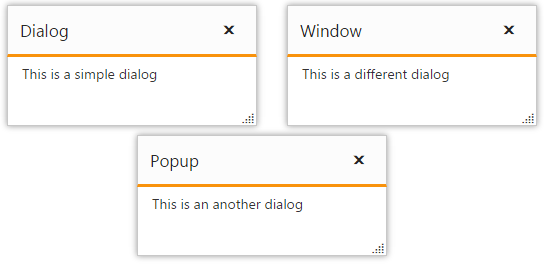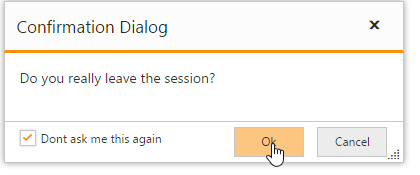How To?
28 Mar 20189 minutes to read
Create Multiple Dialogs
Essential Studio for ASP.NET library supports multiple Dialog widgets in the same web page with different contents and different functionalities.
Initialize the Dialog widgets by configuring as below.
@{
Html.EJ()
.Dialog("firstDialog")
.Title("Dialog")
.Width(250)
.Position(position => position.XValue("20px").YValue("20px"))
.ContentTemplate(@<p>This is a simple dialog</p>)
.Render();
}
@{
Html.EJ()
.Dialog("secondDialog")
.Title("Window")
.Width(250)
.Position(position => position.XValue("300px").YValue("20px"))
.ContentTemplate(@<p>This is a different dialog</p>)
.Render();
}
@{
Html.EJ()
.Dialog("thirdDialog")
.Title("Popup")
.Width(250)
.Position(position => position.XValue("150px").YValue("150px"))
.ContentTemplate(@<p>This is an another dialog</p>)
.Render();
}NOTE
If the position of the dialog is not set as above, all the three dialogs will be overlapped with each other.

Create Nested Dialog
A Dialog widget can be nested within another Dialog widget.
Create a div element to render the child Dialog widget and use it as a content of parent Dialog widget.
@{
Html.EJ()
.Button("outerButton")
.Text("Open Dialog")
.Type(ButtonType.Button)
.ClientSideEvents(clientEvent => clientEvent.Click("openDialog"))
.Render();
}
@{
Html.EJ()
.Dialog("outerDialog")
.Title("Dialog")
.Width(500)
.Height(400)
.ShowOnInit(false)
.ContentTemplate(@<div>
@Html.EJ().Button("innerButton").Text("Open Nested Dialog").ClientSideEvents(clientEvent => clientEvent.Click("openNestedDialog"))
</div>)
.Render();
}
@{
Html.EJ()
.Dialog("secondDialog")
.Title("Window")
.Width(400)
.Height(300)
.ShowOnInit(false)
.ContentTemplate(@<p>This is a nested dialog</p>)
.Render();
}Add the below script to the view page
<script>
function openDialog() {
$("#outerDialog").ejDialog("open");
}
function openNestedDialog() {
$("#secondDialog").ejDialog("open");
}
</script>Create a Confirmation Dialog with Footer section
Essential JS library supports Alert Dialog widgets.
Using ShowFooter property to render Alert Dialog with Footers in Dialog widget.
Create a Dialog Widget with enabling Footer property.
<div class="control">
@Html.EJ().Button("btnOpen").Size(ButtonSize.Medium).Type(ButtonType.Button).Height("30").Width("150").ClientSideEvents(evt=>evt.Click("onOpen")).Text("Click to open dialog")
@{Html.EJ().Dialog("basicDialog").Containment(".control").Title("Software Installation Agreement").ContentTemplate(
@<div class="cnt">
Do you really leave the session?
</div>).Target(".control").ShowFooter(true).FooterTemplateId("sample").ClientSideEvents(evt => evt.Close("onDialogClose")).Render();
}
</div>Add the following script to close and open the Dialog widget.
$("#btnOpen").hide();
function onDialogClose(args) {
$("#btnOpen").show();
}
function onOpen() {
$("#btnOpen").hide();
$("#basicDialog").ejDialog("open");
});Initialize Footer in Dialog widgets by adding the script section as below.
<script id="sample" type="text/x-jsrender">
<div class="footerspan" style="float:right">
@Html.EJ().Button("btn1").Size(ButtonSize.Mini).Height("30").Width("70").Text("Ok")
@Html.EJ().Button("btn2").Size(ButtonSize.Mini).Height("30").Width("70").Text("Cancel")
</div>
<div class="condition" style="float:left; margin-left:15px">
@Html.EJ().CheckBox("check1").Text("Don't ask me this again")
</div>
</script>
Render Dialog from Code behind
Dialog can be rendered from the code behind by initializing the required properties in controller and passing those properties via ViewData or Model to the client side.
The following code illustrates the initialization of Dialog properties in the controller.
//Namespace to get the JavaScript (Dialog) component properties
using Syncfusion.JavaScript;
using Syncfusion.JavaScript.Models;
namespace MvcApplication.Controllers
{
public class DialogController : Controller
{
public ActionResult DialogFeatures()
{
//Initializing the Dialog model
DialogProperties DialogObj = new DialogProperties();
//Initializing the content and other properties
DialogObj.ShowOnInit = true;
DialogObj.Title = "My Dialog";
DialogObj.ContentTemplate = new MvcTemplate<object>
{
RazorViewTemplate = (data) =>
{
return "This is Dialog content";
}
};
DialogObj.Width = "550";
DialogObj.IsResponsive = true;
//Passing Dialog properties using the ViewData
ViewData["DialogModel"] = DialogObj;
return View();
}
}
}Binding the Dialog properties passed via ViewData from the controller in the client side as below.
@{
Html.EJ().Dialog("basicDialog", (Syncfusion.JavaScript.Models.DialogProperties)ViewData["DialogModel"]).Render(); // render the Dialog in view
}